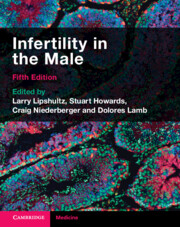Book contents
- Infertility in the Male
- Infertility in the Male
- Copyright page
- Contents
- Contributors
- Foreword
- Abbreviations
- Introduction
- Section 1 Scientific Foundations of Male Infertility
- Section 2 Clinical Evaluation of the Infertile Male
- Section 3 Laboratory Diagnosis of Male Infertility
- Section 4 Treatment of Male Infertility
- Chapter 21 Medical Treatment of Male Infertility
- Chapter 22 Surgery to Improve Sperm Delivery
- Chapter 23 Sperm Retrieval Surgery
- Chapter 24 The Use of Sperm in Medically Assisted Reproduction
- Chapter 25 Male Oncofertility – Considerations for Fertility Preservation and Restoration
- Chapter 26 Male Contraception
- Chapter 27 Future Directions in Male Infertility
- Section 5 Health Care Systems and Culture
- Index
- References
Chapter 23 - Sperm Retrieval Surgery
from Section 4 - Treatment of Male Infertility
Published online by Cambridge University Press: 08 July 2023
- Infertility in the Male
- Infertility in the Male
- Copyright page
- Contents
- Contributors
- Foreword
- Abbreviations
- Introduction
- Section 1 Scientific Foundations of Male Infertility
- Section 2 Clinical Evaluation of the Infertile Male
- Section 3 Laboratory Diagnosis of Male Infertility
- Section 4 Treatment of Male Infertility
- Chapter 21 Medical Treatment of Male Infertility
- Chapter 22 Surgery to Improve Sperm Delivery
- Chapter 23 Sperm Retrieval Surgery
- Chapter 24 The Use of Sperm in Medically Assisted Reproduction
- Chapter 25 Male Oncofertility – Considerations for Fertility Preservation and Restoration
- Chapter 26 Male Contraception
- Chapter 27 Future Directions in Male Infertility
- Section 5 Health Care Systems and Culture
- Index
- References
Summary
Sperm retrieval is most commonly performed for azoospermic men. Azoospermia may be the result of severely impaired sperm production (azoospermia due to spermatogenic dysfunction) or normal sperm production in the setting of physical blockage of sperm transport (obstructive azoospermia). Although microsurgical reconstruction is possible for many men with obstructive azoospermia, some couples will still elect sperm retrieval with use of assisted reproductive technology (ART), including in vitro fertilization (IVF) and intracytoplasmic sperm injection (ICSI). ART allows men who have surgically retrieved sperm to contribute to pregnancies, even when limited numbers of viable sperm are available and even if sperm have not matured by proceeding through the entire male reproductive system. The management of men with obstructive azoospermia and of those with azoospermia due to spermatogenic dysfunction is markedly different. Not only does the genetic/diagnostic testing vary for these two conditions, but also the management and outcomes take different directions.
- Type
- Chapter
- Information
- Infertility in the Male , pp. 437 - 445Publisher: Cambridge University PressPrint publication year: 2023



